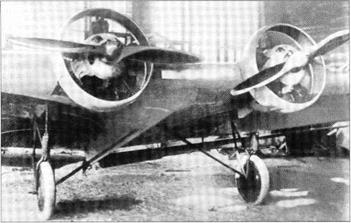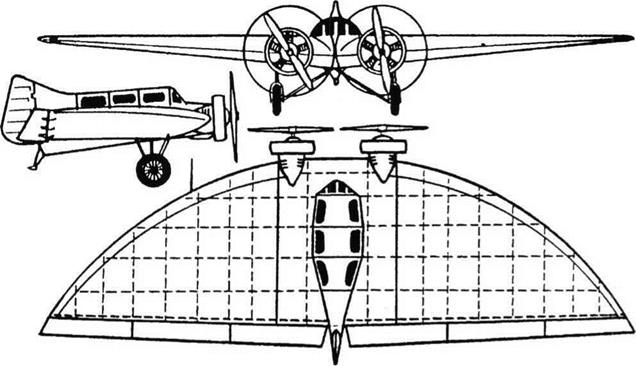BICh-14
Purpose: To test an improved twin-engined ‘Parabola’.
Design Bureau: B I Cheranovskii.
In 1933 Cheranovskii schemed his first design with twin engines, the BICh-10. Later in that year he tested a tunnel model, and by 1934 he had made so many (mostly minor) changes that he redesignated it as the BICh-14. It interested the Central Construction Bureau, and thus received their designation CCB-10 (TsKB-10). With their assistance the aircraft was built, and the flight-test programme was opened at the end of 1934 by Yuri I Piont – kovskii. Having no slipstream, the rudder was ineffective, and it was difficult to equalise pro
peller thrusts. On landing, with engines idling, a heavy stick force was needed to get the tail down. Though it was not one of the better BICh designs, having almost no directional stability and being extremely reluctant to respond to pilot inputs, it was submitted for NIl – WS testing. Here such famous pilots as Stefanovskii, Petrov and Nyukhtikov flew it, or attempted to. Various changes made this aircraft marginally acceptable, but attempts to improve it ceased in 1937 Again this was a wooden aircraft, with a skin of veneer (over the leading edge) and fabric. An innovation was to use aluminium to make the embryonic fuselage, which seated up to five, and the integral fin. The wing
had four spars and 60 ribs, and was made as a centre section, of 3.3m (10ft l0in) span, and bolted outer panels. Close together on the leading edge were the two l00hp M-ll engines, with Townend-ring cowls, aluminium nacelles and U-2 type wooden propellers. As before, virtually all the development effort went into improving the trailing-edge controls, of which there were three on each wing, all hung in the usual Junkers style below the trailing edge. For most of the time the four inner surfaces were elevators and the outers ailerons, but at times the middle surfaces were tested as flaps.
The BICh-14 apparently did nothing to enhance its designer’s reputation.
|
|||||||||||||||||||||
|


Purpose: To attempt to fly on human muscle power.
Design Bureau: B I Cheranovskii.
Ever one to explore fresh ideas, in 1934 Cheranovskii obtained financial support from Osoaviakhim (the Society of Friends of the Aviation and Chemical industries) for his pro
posal to build a man-powered ornithopter (flapping-wing aircraft). It could not be made to fly.
This bird-like machine consisted mainly of a flexible wing. The pilot placed his feet on a rudder bar directly under the rudder and then bent forward between two vestigial fins until he could grasp the spade-grip which, via the
two struts seen in the photo, flapped the wings. The two struts and vertical operating rod were pivoted at the bottom to a curved landing skid.
Data not recorded.
|











